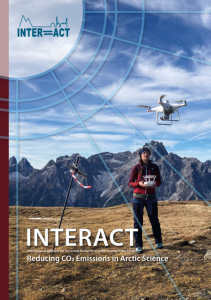 Together with APECSAssociation of Polar Early Career Scientists.... More, INTERACT launches a guidebook on how to reduce CO2 emissions from Arctic Science.
Together with APECSAssociation of Polar Early Career Scientists.... More, INTERACT launches a guidebook on how to reduce CO2 emissions from Arctic Science.
The guidebook is intended to inspire individuals to engage in efforts to reduce Greenhouse GasA gas found in the earth's atmosphere that traps heat radiated from the surface of the earth, and causes the earth's temperature to rise. The term comes from the fact... More emissions from ArcticDefinitions of the Arctic vary according to environmental, geographical, political, cultural and scientific perspectives. Some scientists define the Arctic as areas having a high latitude, long winters, short, cool summers,... More Science, through actions at the personal level and the institutional level. The book provides background information on global CO2 emissions and international efforts to regulate emissions, provides guidance on the complex issue of carbon footprint calculations and compensation schemes, and it discusses the necessity and impacts of travel related to both fieldwork and conferences.
Scientists are among the largest emitters of Greenhouse Gases. We need to continue research and monitoring efforts in our endeavours to understand climate changeAccording to the United Nations Framework Convention on Climate Change, climate change is change in the climate of the whole Earth or a region of the Earth that is believed... More and its impact in the ArcticDefinitions of the Arctic vary according to environmental, geographical, political, cultural and scientific perspectives. Some scientists define the Arctic as areas having a high latitude, long winters, short, cool summers,... More, but we need to be smarter and reduce emissions wherever we can. We need to act — the challenges society faces from emissions are known, and tools and mechanisms already exist to reduce emissions.
The final chapter of the guidebook describes how we need to move towards a more sustainable future for the scientific world. Here tips, tools and considerations are presented to help scientists, conference organisers and institutions consider how emissions can be minimised.
The book was developed by INTERACT station managers together with APECSAssociation of Polar Early Career Scientists.... More members and and it is freely available from our websites.
